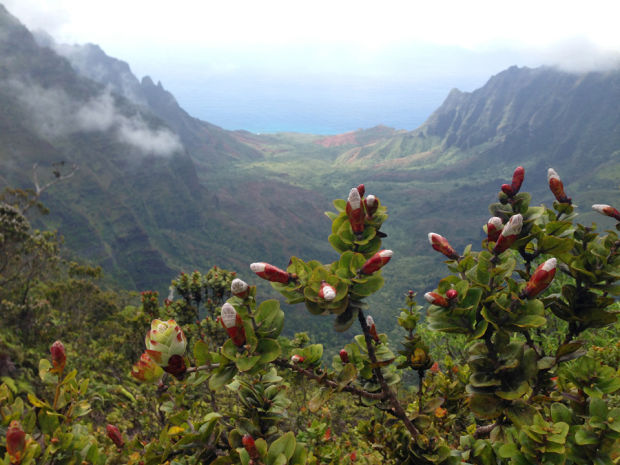LIHU‘E — Green mokihana berries intertwined with maile vines are the main components of Kaua‘i’s trademark lei. While neither of these endemic plants are endangered, thoughtless harvesting at accessible locations could affect available supplies for future generations, according to cultural
LIHU‘E — Green mokihana berries intertwined with maile vines are the main components of Kaua‘i’s trademark lei. While neither of these endemic plants are endangered, thoughtless harvesting at accessible locations could affect available supplies for future generations, according to cultural practitioners.
“The one who receives a mokihana lei, it’s like receiving diamonds,” cultural practitioner Chucky Boy Chock said. “It’s much more than special.”
Keahi Manea, secretary of Ka‘imi Na‘auao o Hawai‘i Nei Institute, said mokihana, which grows on Kaua‘i, is the island’s gift to Hawai‘i.
“You haven’t really gotten a lei on Kaua‘i until you’ve gotten a mokihana lei,” Manea said. “It symbolizes all that we have here that is unique to this island.”
Mokihana has a sap that can cause severe skin rashes. Manea said for that reason, the berries are wrapped around maile vines or other flowers, and the leis are put over clothing to avoid skin contact.
Despite an abundance of mokihana trees in Koke‘e, Manea said a lot of these trees are deep in the forest, in areas visited mostly by horseback riders and hunters. For hula students and those who want to make leis for graduation ceremonies, access to remote areas is difficult, she said.
In the more accessible areas, Manea said she doesn’t see many small trees or seedlings anymore.
Some people, she said, trample picking areas, unaware of what’s under their feet, pick all mokihana berries from the trees, and many times break branches in the process.
“My philosophy is: We want to have sustainable maile and mokihana supplies for the everyday person that goes up to Koke‘e. We all need to treat the area in an ecologically respectful manner,” said Manea, adding that people on Kaua‘i are fortunate to have an accessible area such as Koke‘e to gather material for leis.
Hawaiian protocol taught by many kumu dictates those gathering lei material should leave the area as if no one was there, according to Manea.
But it doesn’t always happen that way.
On April 4, one of her family members went to a favorite maile picking area in Koke‘e and was astonished to find it in poor condition. Short and young maile tendrils were stripped, vines were pulled down and broken, mokihana branches were pulled to the ground and denuded, ferns were stripped and pulled out by their roots, and the ground was trampled, she said.
This kind of vandalism, she said, often happens close to festivals and graduation season.
A cultural practitioner speaking on condition of anonymity, said an off-island halau staying in Koke‘e for the Queen Emma Festival “got a scolding” after being caught pulling maile vines from a canopy in an area behind their rented cabin.
“They pulled the whole thing right off,” said the cultural practitioner.
Changing mentality
Chock said that in the past, many halau used to “rake” Koke‘e. In the last few years, however, the mentality has changed and the halau are more aware of the consequences of irresponsible harvesting.
Additionally, Chock said the organization of the annual Merrie Monarch Festival on the Big Island used to emphasize a halau should use mokihana in their lei if the plant was mentioned in their song, but that is no longer required.
“I’ll tell you the problem that we do have, it’s maile,” said Chock, adding that volunteers and children from a few Kaua‘i halau have been going up to Koke‘e to replant maile.
Manea said the Koke‘e Resource Conservation Program, with the help of many volunteers, including school children, staff, the Ka‘imi Na‘auao o Hawai‘i Nei group and other organizations, do periodic eradication of invasive species in Koke‘e to allow native plants to propagate.
Kaua‘i Museum Director Jane Gray said that about 10 or 12 years ago the museum supported a moratorium on maile and mokihana on their May Day lei contest.
She agrees native plants have to be taken care — not just the maile and the mokihana.
“Don’t abuse and take more than what you need,” Gray said.
Manea said the correct way to pick mokihana is to watch the ground and be mindful of what’s around. People should also make sure some berries are left to mature on the tree.
“If you pick all the berries from a tree, that tree doesn’t have a chance to propagate,” Manea said.
Chock said the ultimate thing is to respect the land.
“You don’t just take it; you take and replant it,” he said. “That is the protocol. None of us own the ‘aina, it’s there for everyone.”
Secret spots
Chock said “Grandma” Julia Sueoka, who is almost 90 years old, had a secret place in Koke‘e where she would frequently pick maile for leis. When she moved to Honolulu to take care of her husband, she told Chock where the spot was.
Chock said he went there two weeks ago and it was full of maile.
“They miss grandma,” he said.
Chock said Westside residents go deep in the forest to places only they know to harvest “big marbles.”
But there are some places on the Eastside where mokihana thrives and nobody talks about it, he said.
“Mokihana is a secret that no one wants to expose, because you want that tree to bear fruit all the time,” Chock said.
• Léo Azambuja, staff writer, can be reached at 245-0452 or lazambuja@ thegardenisland.com.


